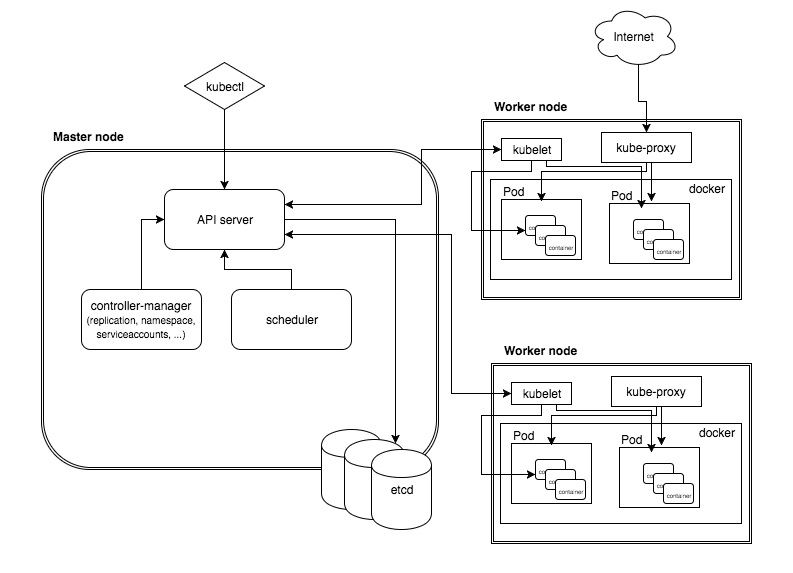kubectl 实用指南

kubectl 是 Kubernetes 的命令行工具,通过 API server 与集群进行交互。
2. 配置 kubectl
kubectl 可以通过 ~/.kube/config 配置连接到一个或多个集群。
具体如何配置可以参考: 配置对多集群的访问 。如果需要配置远程集群,可以参考: 搭建远程 Kubernetes 开发环境 。
查看配置的集群:
$ kubectl config get-contexts CURRENT NAME CLUSTER AUTHINFO NAMESPACE * minikube minikube minikube
选择某个集群:
$ kubectl config set-context minikube Context "minikube" modified.
3. kubectl 命令
$ kubectl kubectl controls the Kubernetes cluster manager. Find more information at: https://kubernetes.io/docs/reference/kubectl/overview/ Basic Commands (Beginner): create Create a resource from a file or from stdin. expose Take a replication controller, service, deployment or pod and expose it as a new Kubernetes Service run Run a particular image on the cluster set Set specific features on objects run-container Run a particular image on the cluster. This command is deprecated, use "run" instead Basic Commands (Intermediate): get Display one or many resources explain Documentation of resources edit Edit a resource on the server delete Delete resources by filenames, stdin, resources and names, or by resources and label selector Deploy Commands: rollout Manage the rollout of a resource rolling-update Perform a rolling update of the given ReplicationController scale Set a new size for a Deployment, ReplicaSet, Replication Controller, or Job autoscale Auto-scale a Deployment, ReplicaSet, or ReplicationController Cluster Management Commands: certificate Modify certificate resources. cluster-info Display cluster info top Display Resource (CPU/Memory/Storage) usage. cordon Mark node as unschedulable uncordon Mark node as schedulable drain Drain node in preparation for maintenance taint Update the taints on one or more nodes Troubleshooting and Debugging Commands: describe Show details of a specific resource or group of resources logs Print the logs for a container in a pod attach Attach to a running container exec Execute a command in a container port-forward Forward one or more local ports to a pod proxy Run a proxy to the Kubernetes API server cp Copy files and directories to and from containers. auth Inspect authorization Advanced Commands: apply Apply a configuration to a resource by filename or stdin patch Update field(s) of a resource using strategic merge patch replace Replace a resource by filename or stdin convert Convert config files between different API versions Settings Commands: label Update the labels on a resource annotate Update the annotations on a resource completion Output shell completion code for the specified shell (bash or zsh) Other Commands: api-versions Print the supported API versions on the server, in the form of "group/version" config Modify kubeconfig files help Help about any command plugin Runs a command-line plugin version Print the client and server version information Usage: kubectl [flags] [options] Use "kubectl <command> --help" for more information about a given command. Use "kubectl options" for a list of global command-line options (applies to all commands).
使用语法:
$ kubectl [command] [TYPE] [NAME] [flags]
- command,指定要对一个或多个资源执行的操作,例如
create、get、describe、delete。 - TYPE,指定资源类型。资源类型不区分大小写,可以指定单数、复数或缩写形式。例如:
$ kubectl get pod pod_name。 - NAME,指定资源的名称。名称区分大小写。如果省略名称,则显示所有资源的详细信息。例如:
$ kubectl get pods。 - flags,指定可选的参数。例如,可以使用 -s 或 -server 参数指定 Kubernetes API 服务器的地址和端口。
4. kubectl 部署 Jenkins
- 创建 Namespace ,隔离服务
$ kubectl create namespace jenkins
- 使用 Deployment 部署 Jenkins
新增 jenkins-deployment.yaml 文件。
$ cat jenkins-deployment.yaml
apiVersion: extensions/v1beta1
kind: Deployment
metadata:
name: jenkins-deployment
spec:
replicas: 1
selector:
matchLabels:
app: jenkins
template:
metadata:
labels:
app: jenkins
spec:
containers:
- name: jenkins
image: jenkins:2.60.3
ports:
- containerPort: 8080
执行命令,部署 Deployment。
$ kubectl create -f jenkins-deployment.yaml --namespace=jenkins deployment.extensions/jenkins-deployment created
- 查看相关信息
$ kubectl describe deployments --namespace=jenkins
- 创建 service 暴露服务
新增 jenkins-service.yaml 文件。
$ cat jenkins-service.yaml
apiVersion: v1
kind: Service
metadata:
name: jenkins
spec:
type: NodePort
ports:
- port: 8080
targetPort: 8080
nodePort: 30000
selector:
app: jenkins
执行命令,部署 service ,nodePort 参数指定对外的服务端口。
$ kubectl create -f jenkins-service.yaml --namespace=jenkins
- 访问服务
在浏览器打开链接: http://your_node_host_ip:30000 ,发现需要输入初始密码。
- 从日志获取访问初始密码
查看 Pod 名称:
$ kubectl get pods --namespace=jenkins NAME READY STATUS RESTARTS AGE jenkins-deployment-868cc579df-42lpn 1/1 Running 0 21m
获取密码:
$ kubectl log jenkins-deployment-868cc579df-42lpn --namespace=jenkins
在日志中,可以查看到初始化密码。
5. 参考
- https://kubernetes.io/docs/reference/kubectl/overview/
- https://devopscube.com/setup-jenkins-on-kubernetes-cluster/
正文到此结束
- 本文标签: tar id App Uber jenkins Service 配置 部署 Select http 服务端 CTO 开发 node Features 集群 Proxy Document src https IO API 参数 端口 Authorization cat Pods Kubernetes client ip plugin IDE REST 服务器 Job find bug HTML explain shell ORM UI list update ACE
- 版权声明: 本文为互联网转载文章,出处已在文章中说明(部分除外)。如果侵权,请联系本站长删除,谢谢。
- 本文海报: 生成海报一 生成海报二
热门推荐
相关文章
Loading...











![[HBLOG]公众号](https://www.liuhaihua.cn/img/qrcode_gzh.jpg)

